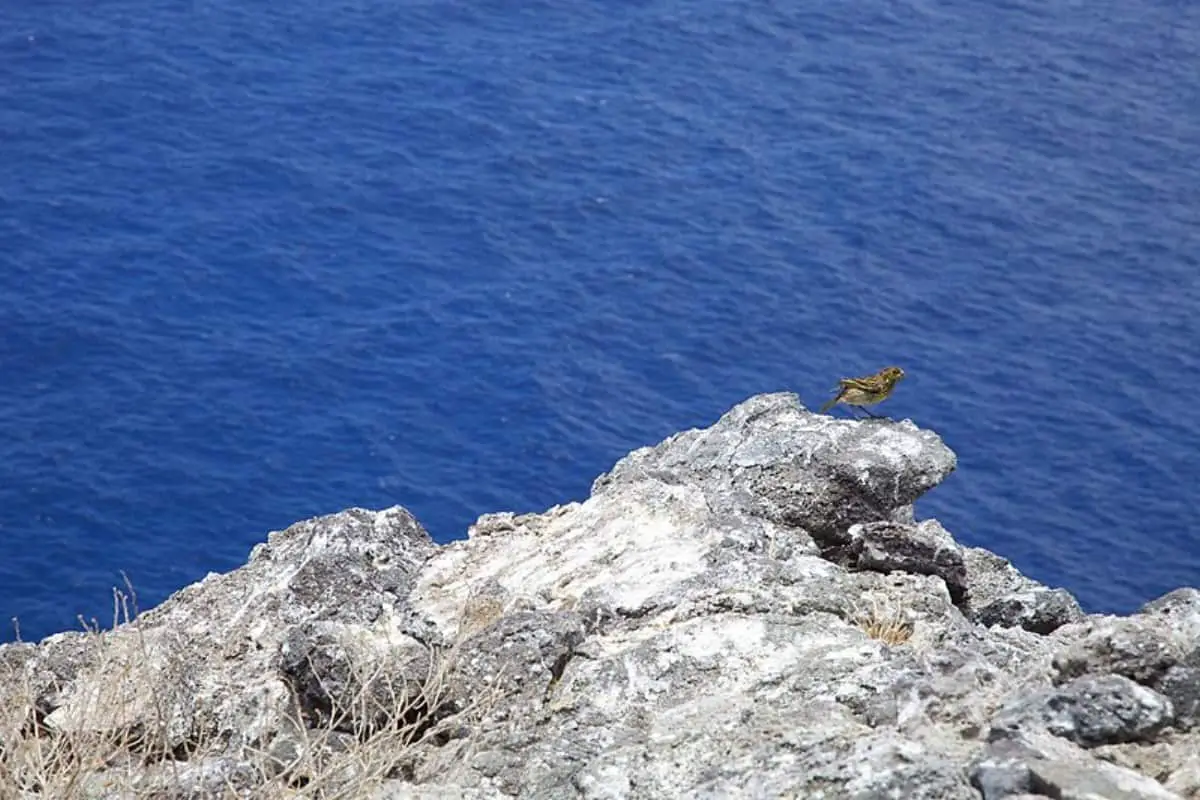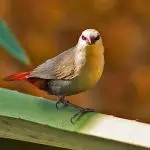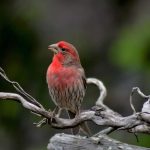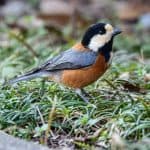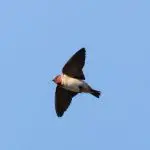Common Name: Nihoa Finch
Scientific Name: (Telespiza ultima)| Size | Diet | Range in Hawaii | Status in Hawaii |
|---|---|---|---|
| 5.5 in. | seeds and other plant materials | Nihoa | Critically Endangered |
The Nihoa Finch (Telespiza ultima) is a small and unique bird species that is native to the island of Nihoa in Hawaii. With its distinctive brown and white plumage and unique foraging behavior, this bird is a beloved sight in its natural habitat.
However, the species is facing a critical conservation status due to habitat loss, predation, and the threat of invasive species, making it an endangered species in Hawaii. In this article, we’ll explore the fascinating world of the Nihoa Finch, its unique adaptations, and its behavior in the wild.
Nihoa Finch
Appearance
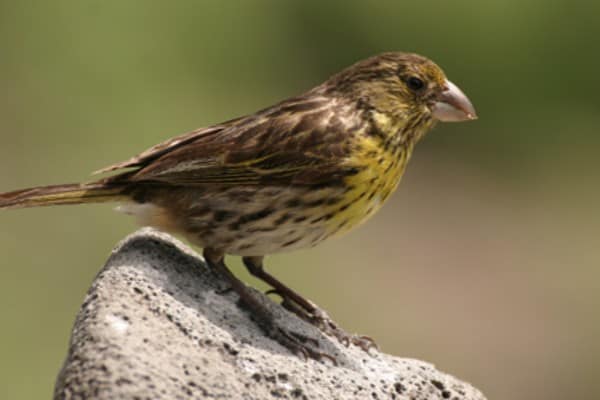
The Nihoa Finch is a small bird with a distinctive appearance. It measures approximately 5.5 inches (14 centimeters) in length. This finch has a compact body with a rounded shape and a relatively short tail.
Its plumage displays a combination of colors, featuring a brownish-gray back and wings, a pale gray throat, and a slightly lighter gray underbelly. The head of the Nihoa Finch is adorned with a dark cap, contrasting with a bright yellow beak and eye-ring.
Its beak is short and pointed, ideal for consuming seeds and other small food sources. Overall, the Nihoa Finch showcases a subtle yet charming color palette that contributes to its unique and beautiful appearance.
Diet
The diet of Nihoa Finches primarily consists of seeds and other plant materials. These finches have adapted to feed on various types of seeds available in their habitat on Nihoa Island. They possess a specialized beak that is short and pointed, allowing them to efficiently crack open and consume seeds.
Additionally, they may also feed on small insects and invertebrates when available, particularly during the breeding season when protein-rich food is crucial for raising their young. While their diet mainly revolves around plant matter, Nihoa Finches demonstrate flexibility in their feeding habits, making use of the resources present in their island environment.
Nesting
The Nihoa Finch typically builds its nest in low vegetation or in rock crevices on its native island of Nihoa. The nest is constructed from grasses and other plant materials and is lined with feathers and other soft materials.
The female Nihoa Finch lays 2-3 eggs per clutch, and both parents take turns incubating the eggs and caring for the young. The young birds fledge and leave the nest after about 20 days. The Nihoa Finch’s nesting behavior is an important part of its life cycle and contributes to the survival of the species.
Behavior
The Nihoa Finch is a small, active bird that is often seen foraging on the ground and in low vegetation. It is a social species that forms small flocks, particularly during the non-breeding season.
The Nihoa Finch is also known for its melodious singing, which is used for communication and mate attraction. During the breeding season, males will perform courtship displays to attract females.
The Nihoa Finch is a diurnal bird, meaning that it is active during the day and rests at night. Its behavior is an important part of its survival in the wild and contributes to the overall health of the species.
Habitat
Its habitat consists of rocky cliffs, shrublands, and grasslands, where it forages for seeds and insects on the ground and in low vegetation. The Nihoa Finch is well-adapted to the arid and rocky environment of its native island, and its survival is closely tied to the health of its habitat.
Due to its restricted range and small population size, the Nihoa Finch is considered an endangered species and efforts are being made to protect and preserve its unique habitat for future generations.
Range
The Nihoa Finch, a species endemic to the Northwestern Hawaiian Islands, specifically inhabits the island of Nihoa. This small bird is confined to the rocky coastline and surrounding areas of Nihoa, which posed challenges for early naturalists attempting to reach the island.
While some individuals mistakenly believed it to be the Wilson’s Laysan Finch initially, it was eventually recognized as a distinct species. The Nihoa Finch’s restricted range and small population size led to its classification as a federally endangered species.
Conservation Status
The Nihoa Finch is listed as critically endangered by the International Union for Conservation of Nature (IUCN) due to its small population size and restricted range on the tiny Hawaiian island of Nihoa. The species is also protected under the United States Endangered Species Act.
Conservation efforts have been focused on habitat restoration, predator control, and monitoring of the population size and health. The Nihoa Finch is considered one of the most endangered bird species in the world, with a population estimated to be between 1,000 and 3,000 individuals.
Interesting Facts
1. Vocalizations
Nihoa Finches are known for their unique vocalizations, which include a variety of chirps, trills, and warbles. These vocalizations are used for communication and courtship displays.
2. Taxonomy
The scientific name for the Nihoa Finch is Telespiza ultima. It is part of the family Fringillidae, which includes other finch species like the Hawaiian Honeycreeper and the Galapagos Finch.
3. Population decline
The Nihoa Finch population has declined dramatically over the past century due to habitat loss, predation by introduced mammals like rats and cats, and competition with non-native bird species.
Frequently Asked Questions
1. What is being done to protect the Nihoa Finch?
Conservation efforts for the Nihoa Finch have focused on habitat restoration, predator control, and monitoring of the population size and health. There have also been successful efforts to stabilize the population on Nihoa Island.
2. Why is the Nihoa Finch critically endangered?
The Nihoa Finch is critically endangered due to habitat loss, predation by introduced mammals like rats and cats, competition with non-native bird species, and climate change.
3. How long do Nihoa Finches live?
The lifespan of Nihoa Finches in the wild is not well documented, but they are believed to live for several years. In captivity, they can live up to 15 years.
4. Can Nihoa Finches be kept as pets?
No, Nihoa Finches are protected under the Endangered Species Act and it is illegal to keep them as pets.
